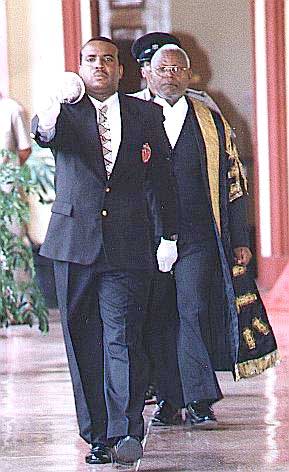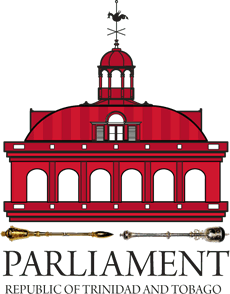 The ornamented maces are carried by the Marshal of the Parliament when he escorts the Presiding Officer in and out of the Chamber at the beginning and end of each sitting of the respective House.
The ornamented maces are carried by the Marshal of the Parliament when he escorts the Presiding Officer in and out of the Chamber at the beginning and end of each sitting of the respective House.
The mace is the symbol of the authority with which the Marshal of the Parliament is vested, in particular of his power to arrest persons without a warrant.
At each sitting, before prayers are read, the Marshal of the Parliament places the Mace on two rests on the table of the Chamber, where it remains (except while the House is in committee) until the end of the sitting. When the House goes into committee and the Presiding Officer leaves the Chair, the Marshal of the Parliament takes the Mace off the table and places it on two brackets below the surface of the table. When the Chairman leaves the Clerk’s chair, the Marshall of the Parliament places the Mace on the table again. When the Mace is not on the table, but on the Marshal of the Parliament’s shoulder, no Member except the Presiding Officer is allowed to speak. No proceedings can take place if the Mace is not in the Chamber, since the Mace indicates the presence of the Presiding Officer.
Mace of the House of Representatives
The Mace of the House of Representatives was donated to the Legislative Council in 1899 and when Trinidad and Tobago achieved Independence in 1962 the Mace was used for the new House of Representatives. To date, the same Mace is still used.

Design Details:
- A two-dimensional silver carving of the Coat-of-Arms is affixed to the top of the Mace.
- The knop or head of the Mace is ornamented with carved motifs and depicts the landing of Christopher Columbus in Trinidad against a background of the Trinity Hills.
- The shaft of the Mace is engraved with the words “LEGISLATIVE COUNCIL OF TRINIDAD AND TOBAGO”, below which is engraved the names of the subscribers to the Mace as follows:
| His Excellency Sir Hubert E.H. Jerningham | Sir F. Lovell, CMG |
| Sir C.C. Knollys, KCMG | G. Goodwille |
| G.T. Fenwick | W. H. Coombs |
| N. Nathan, Q.C. | R. De Verteuil |
| C. Leotaud | D.B. Horsford |
| Sir F.C. Scott, KCB, MCMG | J.A. De Wolf |
| W. Gordon-Gordon | R.H. Mc Carthy |
| V. Brown, Q.C. | L. Guiseppi |
| A.P. Marryat | S. Henderson |
| H.C. Bourne | W. Craig |
| E. Cipriani | W.S. Robertson |
| W. Wrightson | E. Agostini, Q.C. |

Mace of the Senate
The Mace of the Senate was commissioned in June 1966 in order to prepare for the ceremonial opening of Parliament on August 31, 1966 and so that simultaneous meetings of both Houses could take place. The sole existing Mace, of the former Legislative Council, was to be used for the new House of Representatives.
As early as 1962, a flag and Coat-of-Arms Committee comprising Members of the Legislative Council and several renowned artists such as Carlisle Chang and M.P. Alladin recommended the commissioning of a Senate Mace. Although the Committee recommended that a local metalcraftsman be awarded the commission, the Senate finally chose the British firm of Thomas Fattorini Limited in Birmingham to undertake the work.
The design was loosely based on the Mace of the Parliament of Tanzania in Africa and adapted to local purposes.
Design Details
- A three-dimensional carved Coat-of-Arms of the Republic of Trinidad and Tobago is affixed to the top of the Mace.
- The words “SENATE OF TRINIDAD AND TOBAGO” are engraved immediately below.
- The Coat of Arms is engraved on the knop or head of the Mace.
- The four round panels depict:-
- The Oil Industry
- The Sugar Industry
- The Cocoa Industry, and
- The symbol of the local Manufacturer’s Association not including the letters TMA or the words Trinidad Manufacturer’s Association
- At the top of the base of the shaft, there appears the National Flower (the Chaconia) and another popular flower, the Anthurium Lily.

